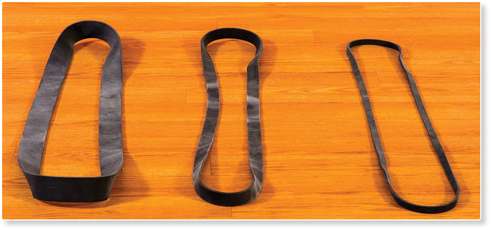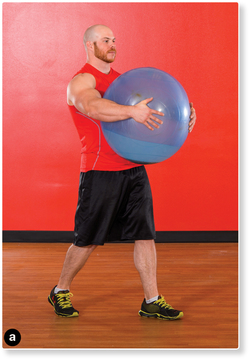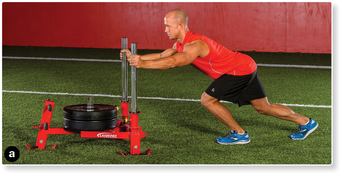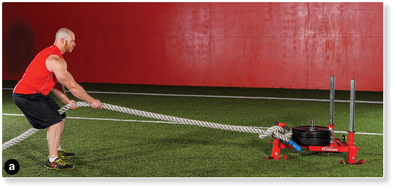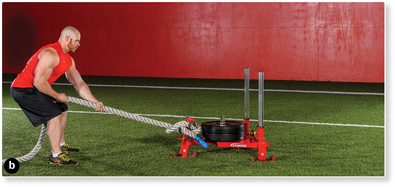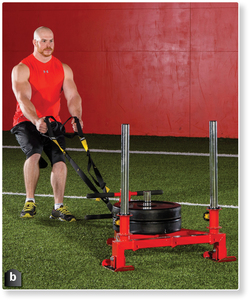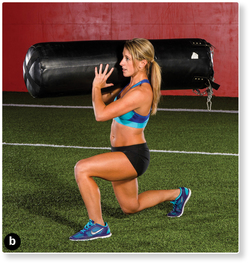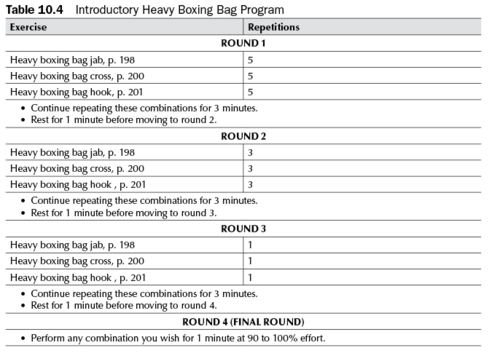Resistance Bands
Resistance bands are extremely versatile and portable pieces of equipment. They take up little space, easily fit in a backpack or suitcase, and allow you to take your workout on the go. For these reasons, they are an ideal piece of equipment for frequent travelers.
Another benefit of resistance bands is that users can adjust the intensity, or training load, to their strength and fitness levels. Thicker bands typically provide more resistance, whereas thinner bands provide less resistance (figure 10.1). But by simply shortening the length of the band or increasing the distance between the attachment point and distal end of the band, resistance can be increased. Thus, these bands can be adjusted to suit a wide range of people with varying abilities. The following are just a few examples of the many options available when using resistance bands.
Heavy Resistance Band Standing Row
Intended Uses
The purpose of the heavy band row is to increase local muscular endurance in the muscles of the rhomboids and middle trapezius.
Prerequisites
- Good shoulder strength and stability.
- Good trunk stability.
Steps
- Wrap the heavy band around a stationary object, such as a squat rack or pole.
- While holding each end of the band, assume an athletic position by bending the ankles, knees, and hips slightly and setting the back.
- Back away from the attachment point until the arms are fully extended (a).
- Pull the band toward the middle of the torso (b) and then extend the arms in a controlled manner until the bands return to the staring position.
- Repeat for the desired number of repetitions.
Key Points
- Perform this exercise as quickly as possible while maintaining control of the resistance band. Do not allow the band to snap back; instead, control the eccentric (lowering) portion of the movement.
- Select a band that creates enough tension so that you are able to perform only 20 to 25 repetitions with proper form and technique before fatiguing.

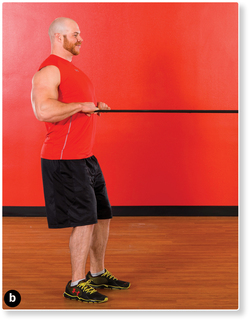
Heavy Resistance Band Standing Chest Press
Intended Uses
The purpose of the band press is to improve local muscular endurance in the muscles of the chest, shoulders, and triceps.
Prerequisites
- Good shoulder strength and stability.
- Good trunk stability.
Steps
- Place the heavy band across the upper portion of your back.
- While holding each end, position the band so that the hands are just under the armpits (a).
- Assume an athletic position by bending the ankles, knees, and hips slightly and setting the back.
- Extend both arms and press the ends of the band away from the body, while using your torso as an anchor (b).
- Return to the starting position in a controlled manner and repeat for the desired number of repetitions.
Key Points
- Perform this exercise as quickly as possible while maintaining control of the resistance band. Do not allow the band to snap back; instead, control the downward phase of the movement.
- Select a band that creates enough tension so that you are able to perform only 20 to 25 repetitions with proper form and technique before fatiguing.


Resistance Band Push-Up
Intended Uses
The purpose of the band push-up is to increase the intensity and resistance used when performing a traditional push-up.
Prerequisites
- Good upper-body strength.
Steps
- Assume a push-up position and, while stabilizing the ends of a band under each hand, stretch the middle portion of the band around your back, across the shoulder blades (a).
- In a controlled manner, lower yourself to the ground and begin performing push-ups as described in chapter 3 (b).
Key Points
- Maintain a rigid torso throughout the exercise movement (i.e., do not allow the hips to sag or the back to arch).
- Lower yourself in a slow, controlled manner and then explode when extending the arms and pressing yourself away from the floor.
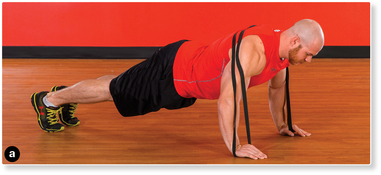
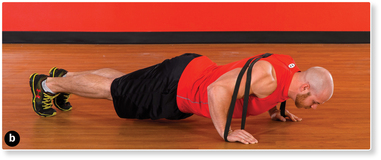
Resistance Band Assisted Pull-Up
Intended Uses
This exercise can be used to strengthen the muscles of the upper back.
Prerequisites
- No preexisting shoulder injuries.
Steps
- Lay the middle of a resistance band over the top of a pull-up bar. Then take one end of the band and pull it through the center of the other end so that it secures the band to the bar.
- Place one foot through the loop and allow the end of the band to hook under the foot.
- Reach overhead and grab the pull-up bar using an overhand grip (a).
- Allow the tension created on the band to assist you in performing the pull-up (b).
Key Points
- Be careful getting in and out of the band attachment. If you perform the exercise incorrectly, the band may inadvertently slip and cause injury.
- Keep the ankle of the band leg flexed at all times (i.e., pull the toes toward the shins).


Heavy Resistance Band Squat
Intended Uses
This exercise is primarily used to increase lower-body muscular endurance.
Prerequisites
- Good form and technique when performing the squat exercise with body weight.
Steps
- Take a heavy band and drape it over your neck so that the center portion is resting on the back of the neck.
- Squat down and bring the band around the outside portion of the feet, anchoring the band under the middle portion of each foot (a).
- Set the back and extend the knees and hips until you are back in a standing position (b).
- Repeat for the desired number of repetitions.
Key Points
- At the lowest portion of the squat exercise, minimal to no tension should be on the band. As you begin to stand, the tension of the band should progressively increase.


